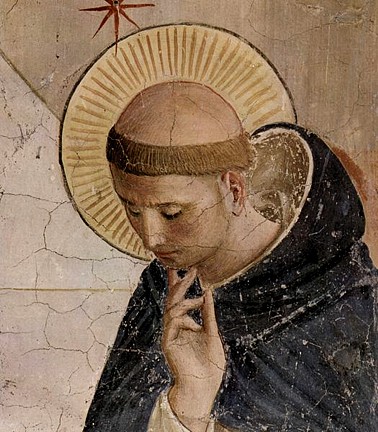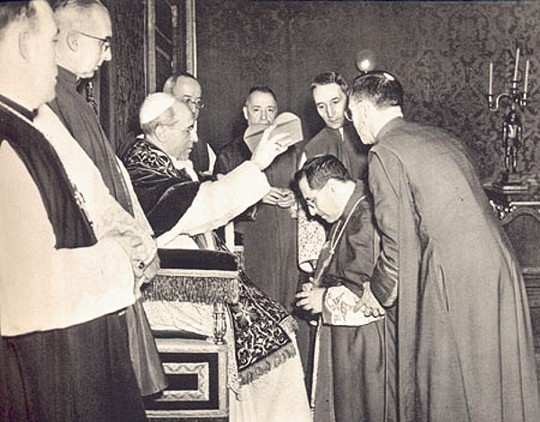Lessico
Chierica o Tonsura

Tonsura
romana
San Domenico di Guzmán (Calaruega ca. 1170 - Bologna 1221)
opera del Beato Angelico alias Fra' Giovanni da Fiesole
al secolo Guido di Pietro (Vicchio di Mugello ca. 1400 - Roma 1455)
Chierica, dal latino ecclesiastico clerica (tonsio), (tonsura) dei chierici, cioè dei membri del clero, era la rasatura tonda sulla sommità del capo di chi veniva iniziato al sacerdozio, e in genere degli ecclesiastici. La tonsura era la cerimonia del taglio dei capelli che segnava il passaggio dallo stato laicale a quello clericale come espressione simbolica di rinuncia al mondo. La consuetudine di rasare completamente il capo (Atti degli Apostoli 18,18) fu in uso nell'antichità cristiana dapprima presso i monaci e passò quindi anche ai chierici. Il rito della tonsura è stato abolito da Paolo VI nel 1972.
Atti degli Apostoli 18,18: Paolo si trattenne a Corinto ancora molti giorni, poi, salutati i fratelli, s’imbarcò per la Siria insieme a Priscilla e ad Aquila, e a Cencre si fece tagliare i capelli, sciolto dal voto che aveva fatto.
Paolo, forse per mostrare ai Giudei che rispettava le usanze ebraiche, aveva fatto il voto temporaneo di nazireato per cui doveva astenersi dal vino, non tagliarsi i capelli finché non avesse offerto il sacrificio a Gerusalemme.

1953
- Pio XII al secolo Eugenio Pacelli (Roma 1876-1958)
mentre impone la berretta cardinalizia
al Cardinale Giuseppe Siri (Genova 1906-1989).
Si può notare la chierica del prelato all'estrema destra.
Nazireato
Nazireato era l’antica usanza ebraica che consisteva nel votarsi solennemente a Dio, per un periodo variabile, da parte del fedele che voleva ottenere una grazia o dedicarsi a vita più pura. Tale consacrazione particolare comportava il rispetto di norme rigorose, tra cui il lasciarsi crescere i capelli e l'astenersi dal vino e da qualsiasi rapporto impuro. Allo scadere del voto ci si radeva e si facevano sacrifici. Le prescrizioni del nazireato si trovano in Numeri 6,2-21.
Tonsure is the practice of some Christian churches, mystics, Buddhist novices and monks, and some Hindu temples of cutting the hair from the scalp of clerics, devotees or holy people as a symbol of their renunciation of worldly fashion and esteem.
History
The
origin of the tonsure remains unclear but it certainly was not widely known in
antiquity. There were three forms of tonsure known in the 7th and 8th
centuries:
The Oriental, which claimed the authority of St. Paul the Apostle (Acts 18:18)
and consisted of shaving the whole head. This was observed by churches owing
allegiance to Eastern Orthodoxy. Hence Theodore of Tarsus, who had acquired
his learning in Byzantine Asia Minor and bore this tonsure, had to allow his
hair to grow for four months before he could be tonsured after the Roman
fashion, and then ordained Archbishop of Canterbury by Pope Vitalian in 668.
The Celtic, which consisted of shaving the whole front of the head from ear to ear, the hair being allowed to hang down behind. An alternate explanation describes the "delta" tonsure cut as a triangle with the apex at the forehead, and the base from ear to ear at the back of the head. The Roman party in Britain attributed the origin of the Celtic tonsure to Simon Magus, though some traced it back to the swineherd of Lóegaire mac Néill, the Irish king who opposed St. Patrick; this latter view is refuted by the fact that it was common to all of the Celts, both insular and continental. Some practitioners of Celtic Christianity claimed the authority of St. John for this, as for their Easter practices. It is entirely plausible that the Celts were merely observing an older practice, possibly from Antioch, which had become obsolete elsewhere.
The Roman: this consisted of shaving only the top of the head, so as to allow the hair to grow in the form of a crown. This is claimed to have originated with St. Peter, and was the practice of the Latin Rite Roman Catholic Church until obligatory tonsure was suppressed in 1972.
These claimed origins are possibly unhistorical; the earliest history of the tonsure is lost in obscurity. This practice is not improbably connected with the idea that long hair is the mark of a freeman, while the shaven head marks the slave (in the religious sense: a servant of God).
Yet another theory is that the tonsure mimics male pattern baldness in an attempt to lend artificial respectability to men too young to display the real thing. Interviewed in the documentary A Hole in the Head, Amanda Feilding, an advocate of trepanation, related her theory that linked the tonsure to this practice.
Among the Germanic tribes there appeared the custom that an unsuccessful pretender or a dethroned king would be tonsured. Then, he had to retire to a monastery but sometimes this lasted only until his hair grew back.
Western Christianity
In the Latin or Western Rite of the Roman Catholic Church, "first tonsure" was, in medieval times, the rite of inducting someone into the clergy and qualifying him for the civil benefits then enjoyed by clerics. Tonsure was a prerequisite for receiving the minor and major orders. Failing to maintain tonsure was the equivalent of attempting to abandon one's clerical state, and in the 1917 Code of Canon Law, any cleric in minor orders (or simply tonsured) who did not resume the tonsure within a month after being warned by his Ordinary, lost the clerical state. Over time, the appearance of tonsure varied, ending up for non-monastic clergy as generally consisting of a symbolic cutting of a few tufts of hair at first tonsure in the Sign of the Cross and in wearing a bare spot on the back of the head which varied according to the degree of orders. It was not supposed to be less than the size of a communicant's host, even for a tonsuratus, someone simply tonsured, and the approximate size for a priest's tonsure was the size of a priest's host. Countries that were not Catholic had exceptions to this rule, especially in the English-speaking world. In England and America, for example, the bare spot was dispensed with, likely because of the persecutions that could arise from being a part of the Catholic clergy, but the ceremonious cutting of the hair in the first clerical tonsure was always required. In accordance with Pope Paul VI's motu proprio Ministeria quaedam of 15 August 1972, "first tonsure is no longer conferred". Since that time, however, certain institutes have been authorized to use the first clerical tonsure, such as the Priestly Fraternity of St. Peter (1988), the Institute of Christ the King Sovereign Priest (1990), and the Personal Apostolic Administration of Saint John Mary Vianney, (2001).
Apart from this general clerical tonsure, some Western Rite monastic orders, for example Carthusians and Trappists, employed a very full version of tonsure, shaving the head entirely bald and keeping only a narrow ring of short hair, sometimes called "the monastic crown" (see "Roman tonsure", above), from the time of entrance into the monastic novitiate for all monks, whether destined for service as priests or brothers. Some monastic orders and individual monasteries still maintain the tradition of a monastic tonsure.
The fuller form of clerical tonsure led to the wearing of a skull cap in church to keep the head warm. This skull cap, called a zucchetto, is still worn by the Pope (in white), Cardinals (in red) and bishops (in purple) both during and outside of formal religious ceremonies. Priests may wear a simple black zucchetto, only outside of religious services, though this is almost never seen except as a practical garment used for warmth by some monks. Some priests who held special titles (certain ranks of monsignori and some canons, for instance) formerly wore black zucchettos with red or purple piping, but this too has fallen out of use except in a few, extremely rare cases.
Eastern Christianity
Today in Eastern Orthodoxy and in the Eastern Catholic Churches of Byzantine Rite, there are three types of tonsure: baptismal, monastic, and clerical. It always consists of the cutting of four locks of hair in a cruciform pattern: at the front of head as the celebrant says "In the Name of the Father", at the back of head at the words "and the Son", and on either side of the head at the words "and the Holy Spirit". In all cases, the hair is allowed to grow back; the tonsure as such is not adopted as a hairstyle.
Baptismal tonsure is performed during the rite of Holy Baptism as a first sacrificial offering by the newly baptized. This tonsure is always performed, whether the one being baptized is an infant or an adult.
Monastic tonsure (of which there are three grades: Rassophore, Stavrophore and the Great Schema), is the rite of initiation into the monastic state, symbolic of cutting off of self-will. Orthodox monks traditionally never cut their hair or beards after receiving the monastic tonsure as a sign of the consecration of their lives to God (reminiscent of the Vow of the Nazirite).
Clerical tonsure is done prior to ordination to any rank, such as reader. This led to a once common usage that one was, for instance, "tonsured a reader", although technically the rite of tonsure occurred prior to the ordination.
Buddhism
In Buddhism tonsure is a part of the rite of pabbajja and also a part of becoming a monk. This involves shaving head and face. This tonsure is renewed as often as required to keep the head cleanly shaven, and some Chinese Buddhist monks will also have 6, 9 or 12 dots on the top of the head, the result of burning the shaven scalp with the tip of a smoking incense stick.
Hinduism
In Hinduism, the underlying concept is that hair is a symbolic offering to the gods, representing a real sacrifice of beauty, and in return, are given blessings in proportion to their sacrifice. Hair cutting (Sanskrit cuda karma, cuda karana) is one of traditional saskaras performed for young children: "According to the teaching of the revealed texts, the Kudakarman (tonsure) must be performed, for the sake of spiritual merit, by all twice-born men in the first or third year." In some traditions the head is shaven completely while in others a small tuft of hair called sikha is left. In some South Indian temples like Tirumala it is customary for pilgrims to shave their heads as a sacrifice to God. There has been an Indian custom to perform a tonsure on widows after their husbands' death. It is not uncommon to tonsure head of child after death of a parent (usually father).
Islam
It is often customary for pilgrims on the Hajj to shave their heads before entering Mecca as a sign of their rejection of vanity and for cleanliness.